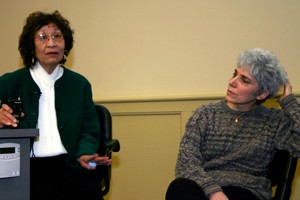
Bringing the Arctic to Cincinnati
Lollie Hopson, an Inupiaq from Barrow, Alaska, just assumed that by flying south, shed be welcomed by sunshine and warm weather.
She was surprised upon her arrival in Cincinnati last Monday, then, when the ice and snow she left behind seemed to magically follow her to the Queen City in the form of a tempestuous mixture. The storm managed to shut down area businesses and close the University of Cincinnati for a day.
I came with the snow and ice, Hopson said laughing. I left it at home and I got it here. In the community at home, its nothing. But in the big city like this, everything stands still.
Not only did Hopson have to borrow a pair of snow boots from friend and colleague Wendy Eisner, associate professor of geography and environmental studies in McMicken College of Arts and Sciences, she was unable to experience the full effect of life in Cincinnati, and how much it must contrast life back home in the northernmost settlement on North Americas mainland.
Those cultural differences were the focus of discussion at UC, when the Center for Environmental Studies held an informal talk on Jan. 30 for students, faculty and other members of the University of Cincinnati community who came to ask Hopson questions about her life on Alaskas North Slope.
The talk, held in Baldwin Hall, had about 100 people in attendance, from students interested in how much snow Barrow gets, to faculty interested in the Inupiat communitys opinion on off-shore drilling in Alaska.
After the informal chat, Hopson joined Eisner and co-instructor Eric Maurer, director of environmental studies, at their honors Environmental Studies class, "Human Dimensions of Climate Change." The students had the opportunity to ask her a myriad of questions about the effects of global climate change that she has experienced in her hometown.
The kids came up with some very interesting questions, Eisner said. People dont have any idea what its like to live in a place like that.

Faculty and students.
Hopson offers a unique perspective because she is experienced in collaborating with the scientists who come to Alaska for their research.
I work with Barrow Arctic Science Consortium and that involves all the researchers and scientists that come to Barrow on different projects, Hopson said. I work as a community liaison, so I help find the people that have the information that is needed.
When Eisner received National Science Foundation funding with fellow geography faculty Ken Hinkel and Richard Beck for their work on drained lakes on the North Slope, she began working with Hopson to recruit local people in the community for their expansive knowledge of the evolving landscape.
Eisner and other members in her research team interview the village elders, asking them questions about the geography of the evolving thaw lakes and recording the changes they note. The abundant amount of data that is accrued by these oral histories give a human dimension to the impact the environment has on peoples lives.
Were always using maps. The Inupiat look at the maps and they tell stories, Eisner said. As soon as one village elder saw a map, Eisner recalled, she had a story about when this happened and that happened when the families were starving one winter. A whole story based on the landscape.
Its overwhelming how much information they have.
Hopson not only sets up Eisners meetings with the locals, she translates the interviews as well, considering some of the inhabitants of Barrow mainly speak Inupiaq. Translation alone can make a one-hour interview turn into a week-long duty, as the Inupiaq language is very complex and considered endangered because of its low usage rate today.
In fact, it was the translation of Inupiaq speaker Ruth Nukapigaks interview that brought Hopson to Cincinnati in the first place. Because Eisner only visits Alaska in the summer months, translating the interview would pose impossible without Hopsons assistance in the same location.
Her visit, while perhaps not a break from the harsh winter elements, was nonetheless productive. She and Eisner managed to translate the information volunteered by Nukapigak, bringing them one step closer to understanding the effects of climate change on Barrow and, ultimately, the world.
Read more about Eisner's work:
UC Faculty Members Break New Ground While Treading Gently on the Alaskan Tundra
Related Stories
From literature to AI: UC grad shares career path to success
April 23, 2024
Before Katie Trauth Taylor worked with international organizations like NASA, Boeing and Hershey, and before receiving accolades for her work in the generative AI space, she was in a much different industry: English and literature.
WVXU: Why is part of Green Township called Dent?
April 23, 2024
UC College of Arts and Sciences professor tells WVXU that Ohio's glacial past might explain how Dent got its name.
Local 12: Local universities open Taylor Swift courses
April 22, 2024
In the lead up to the release of Taylor Swift's new album, "The Tortured Poets Department," several media outlets covered classes offered at UC that focus on the singer's music and poetry. UC offers three classes that cover the pop icon: a general music course at CCM and two classes at A&S.
